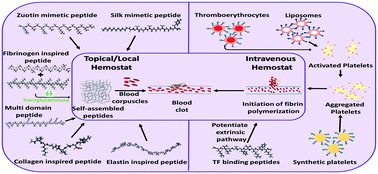Peptide-based topical agents and intravenous hemostat for rapid hemostasis
Abstract
Traumatic coagulopathy due to severe external injury and internal hemorrhage is life-threatening to accident victims and soldiers on the battlefield, causing considerable number of deaths worldwide. Patients with inherited bleeding disorders (such as haemophilia, von Willebrand disease, inherited qualitative platelet defects, and afibrinogenemia) also contribute to the vast number of deaths due to abnormal bleeding, and these patients are difficult to handle during surgery. Platelets and different plasma proteins play an essential role in blood coagulation and in the maintenance of the body's hemostatic balance. The improper function or deficiency of these factors cause abnormal bleeding. To address such bleeding disorders, external clotting agents (such as extracellular protein-inspired natural and synthetic peptide-based sealants and peptide-functionalized polymer/liposome-based sealants) have been developed by different groups of researchers. The primary focus of this review is to provide molecular insights into the existing biologically inspired peptide-based sealants, highlighting the advantages and limitations of such reported designed sealants to handle blood clotting, and also provide insights into the design of improved next-generation surgical sealants.



 Please wait while we load your content...
Please wait while we load your content...